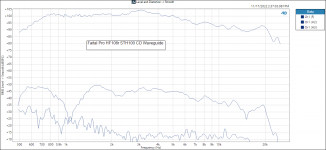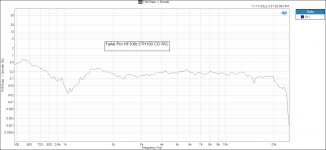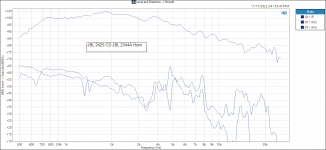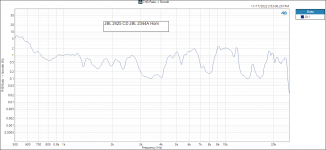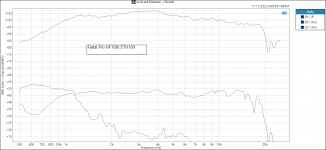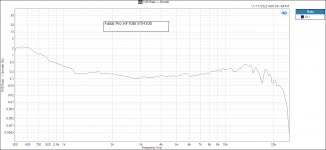I read your post.Higher than speakers that do not have horn / Compression Driver air compression.
Look a bit further into my post for an example of a cone driver.
Cone drivers are absent the air compression and lumpy bumpy acoustic impedance and reflection signature distortions caused by CDs / Horns. You know, the distortion signature that tells you that you are listening to a horn.
Thanks DT
With what CD/Horn do you compare JBL 2123? Some real data?
I read your post.
With what CD/Horn do you compare JBL 2123? Some real data?
Hello,
To a degree it is every CD/Horn. It is my preference to keep CD/Horns out of the midrange for home listening rooms. If you need speakers to reach the back of the auditorium you may need a midrange CD/Horn to get.
It is not Just the JBL 2123 large format midrange that I like. They are cheap and easy to find. The new expensive technology Purifi long stroke drivers measure just a little better.
I am away from my test bench and computer with test results. I will be back near the end of the week.
Meanwhile download this JBL Tech Note to read about CD/Horn compression distortion. Read section 6.
Characteristics of High-Frequency Compression Drivers
Also look up GedLee 's AES papers and at his web site. GedLee claims that that due to masking, CD/Horn 2nd, 3rd HD's and related IMD are not audible up past 10% levels.http://www.gedlee.com/Papers/papers.aspx
You decide what level of distortion is acceptable to you.
Some people prefer the signature distortion of CD/horns.
Thanks DT
The pressure is inside the HF driver - hence the name "compression driver". It means that the diaphragm area is less then the opening the driver is trying to move the air through - hence there will be pressure rise - a compression. Think hand driven pump and bike tyre - thick(er) tube, small(er) nozzle...i am quite sure that the pressures at normal listening levels are completely neglible... Can somebody shine light on this?
E.g you have a 3" cone with a 1 inch opening.
//
To a degree it is every CD/Horn. It is my preference to keep CD/Horns out of the midrange for home listening rooms. If you need speakers to reach the back of the auditorium you may need a midrange CD/Horn to get.
There can be many reasons to use CD/Horns, not only SPL. But SPL is an argument too. If you don't like dynamic compression.
CD/Horns can deliver 110 dB with 1% THD, mostly 2nd. JBL 2123 can do similar, but you still need a HF. And if we talking about 2123 FR its 500-3k, you need a big horn to compare in this range, and it even can be not a CD. Not many audiophiles can use such horns at home. Something bigger, than DD6600? By the way, not bad?
I don't find Purifi measurements at 110 dB, but have some doubts... It's near field stuff? And it strange competitor to CD at all, in my opinion.
And if you listen to music quietly, then distortions of about 1% are still below the noise floor for a typical picture, are they definitely important there? In this case, you can use electrostatics, the distortions are low. If its the main requirement.
Also look up GedLee 's AES papers and at his web site. GedLee claims that that due to masking, CD/Horn 2nd, 3rd HD's and related IMD are not audible up past 10% levels.
Great, then why we should care of HD's? 🙂
(I read this and many other papers)
You decide what level of distortion is acceptable to you.
Some people prefer the signature distortion of CD/horns.
Some people prefer something. I don't think that many of CD/horns people prefer distortions. Maybe even opposite.
I use a pair of SMSL SH9 -Hey,
Not really related to the subject but for home use, what kind of amplifier do you use ?
I have read that headphone amplifier can be used...
https://www.monoprice.eu/products/m...lifier-featuring-thx-aaa-887-technology-eu-uk
Regards Greg
https://www.audiosciencereview.com/...sl-sh-9-thx-headphone-amplifier-review.17519/
amps to drive a coax Mid / Hi B&C DCX464 in a 310Hz Eliptrac (eliptical tractrix) kit horn on my tri amped modified Klipschorns.
https://www.audiosciencereview.com/...amilladsp-tutorial.29656/page-33#post-1299498
First of all, you have no idea how much my ES290s cost and I certainly wasn’t bragging, merely responding to your dogmatic assertion. And I did not assert that horns that are more focussed on loading the driver don’t also offer some degree of controlled directivity - its just a question of where the emphasis of the design is. And BTW I also own a pair of M2s which as you may know feature a waveguide that is arguably the state of the art in relation to controlled directivity (subject to lashings of DSP). No doubt you’ll purposefully misconstrue that once more and again accuse me of bragging.Rest easy.
The Audio Engineering Society Enforcement Division will not be knocking on your door.
Your ES290 bi-radial horns are Controlled Directivity horns.
You did pay a lot for them, so I tend to think that you are bragging just a little bit.
Thanks DT
Hi,I AB compared the HF108 and 4552 (ND version) and after testing many drivers I determined those two to be the best 1inch CDs I could find. The HF108 has a more pronounced and authoritative midrange with an ever so slight amount of squawk in the highs. The BMS 4552 has extremely smooth highs -- as good as any bullet tweeter and possibly any other variety of tweeter I presume. It is less suitable than the HF108 crossed at 900hz as the mids seemed a bit less authoritative. It would probably do the job just fine though and with some EQ likely quite well. I sold the HF108 as I find the CP755ND to be a stunning driver and the best of many Ive tested. I kept the 4552s as they are quite special too in my opinion.
How about FAITAL PRO HF10AK?
Have u heard it?
First of all, you have no idea how much my ES290s cost and I certainly wasn’t bragging, merely responding to your dogmatic assertion. And I did not assert that horns that are more focussed on loading the driver don’t also offer some degree of controlled directivity - its just a question of where the emphasis of the design is. And BTW I also own a pair of M2s which as you may know feature a waveguide that is arguably the state of the art in relation to controlled directivity (subject to lashings of DSP). No doubt you’ll purposefully misconstrue that once more and again accuse me of bragging.
Hello,
Chill just a little.
You and I most likely share more views than you think. However you may drink a bit more of the Kool-Aid.
I am more evidence based.
Where I spoke about Controlled Directivity in 2022 it was tongue in cheek, you know humor. You were deep into the Kool-Aid and missed it.
Speaking of your state of the art D2/M2, CD/Waveguide I have dissected the pair and measured it. CDs/horns and or waveguides are acoustic transformers, their impedance curves are reflected in a electrical impedance sweep. See the attached D2/M2 impedance plot below.
The impedance curve with 3 impedance peaks, count them is one of the least smooth or continuous impedance plots that I have measured.
Thanks DT
Hi,I AB compared the HF108 and 4552 (ND version) and after testing many drivers I determined those two to be the best 1inch CDs I could find. The HF108 has a more pronounced and authoritative midrange with an ever so slight amount of squawk in the highs. The BMS 4552 has extremely smooth highs -- as good as any bullet tweeter and possibly any other variety of tweeter I presume. It is less suitable than the HF108 crossed at 900hz as the mids seemed a bit less authoritative. It would probably do the job just fine though and with some EQ likely quite well. I sold the HF108 as I find the CP755ND to be a stunning driver and the best of many Ive tested. I kept the 4552s as they are quite special too in my opinion.
did you match them in level and response? This is crucial info. Ifs fine if you didn't match them if you are using them in an application that has no opportunity to EQ the driver and its important they have good response from the get go, but this should also be mentioned.
There must be some better and worse drivers out there, but the differences would reduce a lot if you match the responses, especially in home use where they are not pushed to limits. I claim waveguide /horn will change the response again and affect sound much more than swapping the driver. Of course, some drivers might sound better for some particular high pass setting, or the high frequency problems like diaphragm breakup and phase plug issues. These are hard to differentiate though, if the responses are not matched.
I've got this one, and its got very bumpy frequency response, which can be corrected with EQ after which it sounds nice, problem free to my ears. Sound got better by getting better waveguide. I have no other drivers to compare to, need to buy some at some point to test out the stuff I commented above, that CD doesn't matter too much as long as the frequency response is fine, has sensible high pass settings, and its not broken.Hi,
How about FAITAL PRO HF10AK?
Have u heard it?
I did not match levels nor eq. In most instances levels were near identical and I am astute enough to be aware of these circumstances and able to discern the differences regardless. I had pairs of all the drivers I tested and if I liked one I would install the pair on both channels to compare with another preferable pair. I think anyone with keen ears will come to the same conclusion as I, regardless of however much equalization is applied. As for better drivers, I am not sure whether that is true... The Faital HF10AK is supposedly the other well performing 1 inch Faital cd according to the previous post, some research and others who have owned them though I have not had a chance to hear them. B&C and Kartesian are two other companies that are interesting to me and seem to be progressing designs in new directions. Some would say the Beryllium driver TADs are still the best performing diaphragms in the world and I would agree. However the geometry of those drivers specifically with a very long exit throat is not optimal compared with more compact contemporary short throat drivers -- enabling better dispersion with reduced resonance and thus a much cleaner presentation of sound. Having opened up my CP755NDs the diaphragm is pretty advanced as it appears. I agree a waveguide has a substantial impact on how a driver sounds and if matched properly, for the better.
The compression driver itself is the more important part of the equation in my opinion. I believe this has more to do with geometry and phase plug design than diaphragm and motor characteristics -- though a high flux density, compression, and low mass low distortion diaphragms are at the core of what differentiates a compression driver from other drivers in my opinion. I had an Faital HF1440 on hand at one point which is one of Faitals more expensive drivers. It had a substantial squawk, muffled sound, and lack of clarity compared with other drivers and especially the CP755ND. That is not something I would want to, or believe could be solved with equalization. I found it mediocre at best. I am a minimalist in that I dont believe in applying bandaids to issues that dont need to or shouldnt exist in the first place.
The compression driver itself is the more important part of the equation in my opinion. I believe this has more to do with geometry and phase plug design than diaphragm and motor characteristics -- though a high flux density, compression, and low mass low distortion diaphragms are at the core of what differentiates a compression driver from other drivers in my opinion. I had an Faital HF1440 on hand at one point which is one of Faitals more expensive drivers. It had a substantial squawk, muffled sound, and lack of clarity compared with other drivers and especially the CP755ND. That is not something I would want to, or believe could be solved with equalization. I found it mediocre at best. I am a minimalist in that I dont believe in applying bandaids to issues that dont need to or shouldnt exist in the first place.
Last edited:
Hi milezone, thanks for the information. It is not to critisize your observations and methods and use cases. I believe and trust your word. I've found out its very hard to convey information on the forums and visuals in general, as there is no auditory experience accompanied. Lots of minute detail goes into performance and perception so quite a lot of information in written form is required to get right message to readers, prevent misconception.
Here is example with HF10AK I have, bought it because got impression from forums it has good sound. I've found out the sound (sound of the whole system) gets a lot better with EQ to extent that I would not ever choose or recommend it for passive crossover loudspeaker systems. This is something nobody wrote about, or at least I didn't see it / read it.
Reasoning from this the driver is either very good sounding, better than people who wrote about it ever heard, or they just didn't tell all, or I didn't read it all, or they didn't know. Perhaps they had waveguide that sounded better with 10AK than some other driver they compare to while saying its a good one?Perhaps they used EQ as well? or perhaps their hearing loss is worse than mine so "extra sparkle" sounds good if there is no EQ? or any number of other reasons I do know nothing about. Basically, I think people have good intentions and I have no problem believing what their experience was, its just easy get misconception while reading, its hard to relate all the moving parts of theirs to mine.
The driver sounds fine in a system, need to try another one just in case it sounded better but I cannot buy drivers per rumor level knowledge anymore 😉
Here is example with HF10AK I have, bought it because got impression from forums it has good sound. I've found out the sound (sound of the whole system) gets a lot better with EQ to extent that I would not ever choose or recommend it for passive crossover loudspeaker systems. This is something nobody wrote about, or at least I didn't see it / read it.
Reasoning from this the driver is either very good sounding, better than people who wrote about it ever heard, or they just didn't tell all, or I didn't read it all, or they didn't know. Perhaps they had waveguide that sounded better with 10AK than some other driver they compare to while saying its a good one?Perhaps they used EQ as well? or perhaps their hearing loss is worse than mine so "extra sparkle" sounds good if there is no EQ? or any number of other reasons I do know nothing about. Basically, I think people have good intentions and I have no problem believing what their experience was, its just easy get misconception while reading, its hard to relate all the moving parts of theirs to mine.
The driver sounds fine in a system, need to try another one just in case it sounded better but I cannot buy drivers per rumor level knowledge anymore 😉
Last edited:
While a quote rumor... the driver to test against would be the CP755ND in my opinion. I have a single extra one on hand which I plan to list here or ebay once I get around it. I think it would be worth your while to start there. I would look to drivers that are extended to 20khz only without eq and rule out the rest. Distortion occurs at various points in the higher frequencies depending on the diaphragm material which determines the frequency of breakup modes. This effects the performance of the driver on the whole and those which are more extended and least distorted at high frequencies will preform best.The driver sounds fine in a system, need to try another one just in case it sounded better but I cannot buy drivers per rumor level knowledge anymore 😉
Much less expensive than the CP755ND, the 1 inch Beyma CP380M is supposedly quite good. I am curious to hear your impressions if you ever do get around to comparing your HF10AKs with any other drivers.
Hello,I read your post.
With what CD/Horn do you compare JBL 2123? Some real data?
Real data.
See the attached plots for data a 1 foot distance from driver both at calibrated 100dB. This is about 90dB at 8 feet away from the speaker, kinda a medium loud listening level.
JBL2123H in 0.67 cubic foot test enclosure.
CD is JBL D2 as used in M2 speaker
WG is JBL for speaker STX825 (Progressive Transition 90 x 50)
https://reconingspeakers.com/products-page/jbl-horn-lens-5006815-stx825/
Note that the cone driver and CD/WG have different ratios of 2nd to 3rd HD's.
Thanks DT
If there is an interest I will also post plots for HF108/STH100 CD/WG.
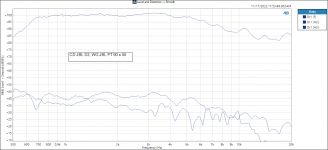
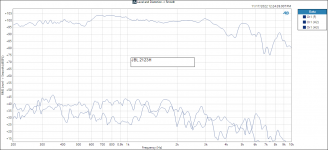
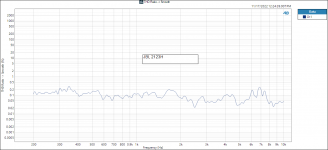
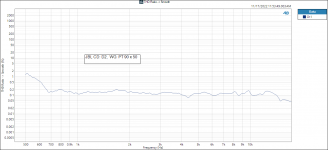
Thank you!
But correct me if I am wrong: we have quite similar THD levels, lower 3rd in CD, which is better.
And you need a HF driver (with its own distortions) for JBL. (And crossover in sensitive region)
In M2 WG it's a chance for even better results for CD?
Thus it does not conclude:
This was predictable.Note that the cone driver and CD/WG have different ratios of 2nd to 3rd HD's.
But correct me if I am wrong: we have quite similar THD levels, lower 3rd in CD, which is better.
And you need a HF driver (with its own distortions) for JBL. (And crossover in sensitive region)
In M2 WG it's a chance for even better results for CD?
Thus it does not conclude:
Like it or not air compression is not linear and causes much higher 2nd and 3rd HD's
HelloThank you!
This was predictable.
But correct me if I am wrong: we have quite similar THD levels, lower 3rd in CD, which is better.
And you need a HF driver (with its own distortions) for JBL. (And crossover in sensitive region)
In M2 WG it's a chance for even better results for CD?
Thus it does not conclude:
You asked what Cd was being used with the JBL 2123.
I showed you the D2 plots in reply.
The D2 is a special case with 2 diaphragms, not a good example of classic CD Compression distortion.
The M2 is huge, too large to use with the JBL 2123. In my thoughts.
See attached plots for the D2/M2.
Thanks DT
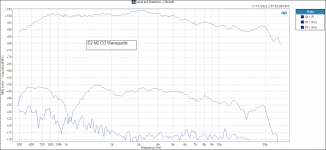
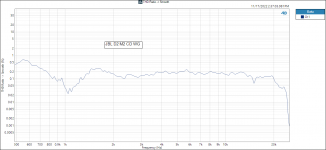
4th order electrical high pass at 500hz is good?Just for fun this the Faital Pro HF108r STH100 CD/WG.
Thanks DT
View attachment 1110620View attachment 1110621
Looks like you reposted the D2 M2 plots or vice versa no?Just for fun this the Faital Pro HF108r STH100 CD/WG.
Thanks DT
View attachment 1110620View attachment 1110621
- Home
- Loudspeakers
- Multi-Way
- Best Compression Drivers today 2022?
